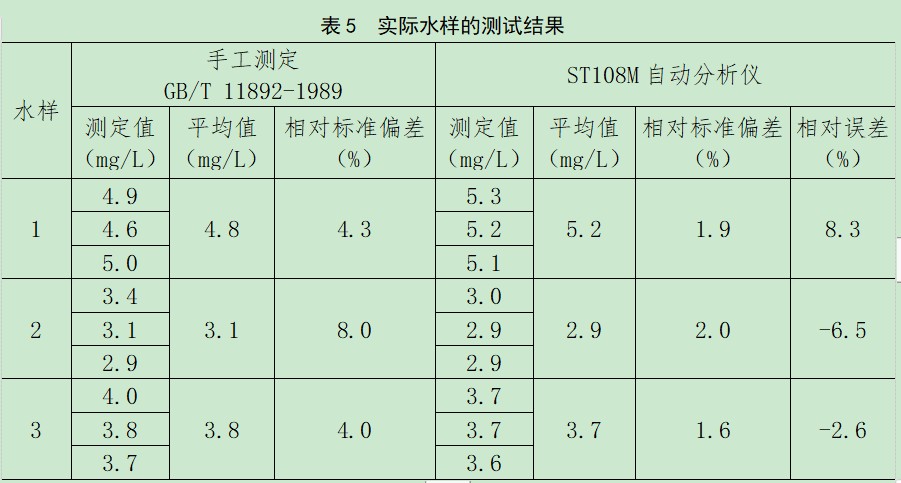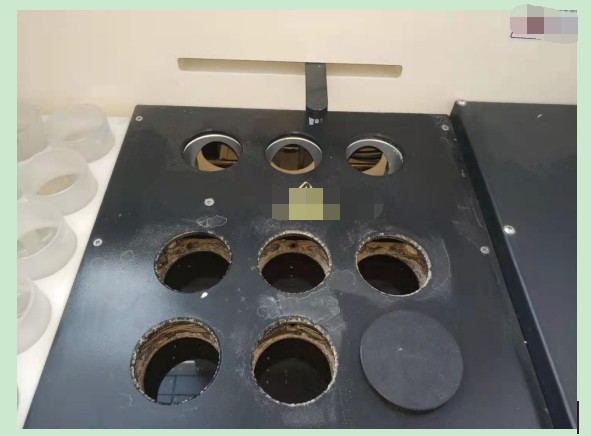In recent years, as the country pays more attention to the field of environmental protection, the "permanganate index CODmn (oxygen consumption)" in water has increasingly become one of the daily mandatory indicators for water quality monitoring laboratories at all levels.
Permanganate index (oxygen consumption) is a conditional indicator experiment. The manual method has many shortcomings: for example, the digestion process requires manual timing; water replenishment is time-consuming and unstable; the titration endpoint is difficult to identify, affecting accuracy; batch analysis requires high quality and ability of operators, etc.
The fully automated instrument for testing the permanganate index (oxygen consumption) is a new product developed by domestic enterprises in recent years. At present, it has a certain market in various parts of the country, but it has not yet been widely popularized. Judging from the usage, most users have good feedback. It can replace manual experiments and greatly improve work efficiency. For example, this is a set of data comparison between our company's ST108M fully automatic permanganate index analyzer and the manual method used by an environmental monitoring station in a city in Jiangsu.
Conclusion: Whether it is standard samples or actual samples, the relative standard deviation (RSD) of the fully automated instrument is better than that of the manual method, and the precision and accuracy of the data are also higher.
With the advancement of technology, it has become an unstoppable trend for automated instruments to replace manual operations. However, how do you choose a fully automatic permanganate index (oxygen consumption) analyzer?
I suggest you consider the following aspects:
First: the number of sample trays and digestion positions on the instrument.
Many new users often feel that the more sample trays and digestion holes, the better; in fact, this is not the case. The number of sample tray positions is not proportional to the number of digestion holes. The more digestion holes, the faster the detection speed. In fact, the number of samples detected by each unit is different. Some units detect thousands of samples per month; some detect dozens of samples per month. Too many will be idle and too few will be insufficient, so the selection of sample trays should be based on the unit's detection tasks; and the number of digestion holes has nothing to do with the number of sample trays, but is related to the titration and endpoint recognition units. For example, when vehicles pass through a highway toll gate, no matter how many queues they are in, if there is only one release channel, the traffic jam will become more and more serious; if you want to improve traffic efficiency, the only correct solution is to open more release channels. Similarly, if you want to increase the detection speed, it depends on the titration and endpoint recognition system behind the digestion program. At present, the detection speed of the mainstream products on the market with single-drop positioning and single-endpoint recognition positions is generally around 7.5-8 minutes per sample; the detection speed of double-drop positioning and double-endpoint judgment positions is around 5-6 minutes;
Second: Automatic sample quantification function. At present, this function is a shortcoming of domestic enterprises, and many enterprises do not have the automatic sample quantification function. Water samples need to be measured one by one with a measuring cylinder and then poured into the sample cup, which needs to be cleaned repeatedly, and the process is cumbersome;
Our company pioneered the automatic sample quantification function of the fully automatic permanganate index tester. The operator only needs to pour the collected water sample into the sample cup, and the rest of the work is completed automatically by the instrument, which greatly improves the work efficiency of the project and reduces the workload of the operator;
Third: Heating tools or methods. GB5750 and GB11829 both stipulate the use of water bath heating, so mainstream manufacturers have adopted this design, but the water consumption during sample digestion is relatively large, so the water tank should be designed with an automatic water replenishment function. However, it is recommended not to use the instrument that uses the electrode method to determine the water level limit used by some manufacturers, otherwise you can only add tap water, which will easily cause scaling and corrosion of the water tank after long-term use.
The ST108M/ST1900 high-precision fully automatic permanganate index tester produced by our company adopts the automatic water replenishment function of the water bath, and the pure water replenished is at the same temperature as the water bath heating zone, avoiding the influence of water temperature fluctuations on water sample digestion during the water replenishment process.Fourth: Selection of reagent pump.
When using a fully automatic permanganate index tester to add reagents and titrate, the industry usually uses a syringe pump as a tool to add reagents with high precision, but the disadvantage is that the cost is high. Some manufacturers initially used peristaltic pumps, but soon gave up because they could not meet the experimental requirements, so they had to use the same type of rotary pumps, etc., but the accuracy is still worse than that of syringe pumps;
Our company uses imported high-precision syringe pumps, the titration accuracy error is less than 0.003%, and the uniquely designed titration head structure allows each drop to be accurate to 0.01ml.
Fifth: Selection of endpoint recognition sensor.
At present, mainstream manufacturers have adopted color sensors that replace the human eye to identify the titration endpoint. The advantage is that it is consistent with the national standard and determines the titration endpoint by identifying the color of the water sample; however, the cost of the color sensor almost determines the manufacturer's product positioning and reliability. The cost varies greatly, ranging from several thousand yuan to tens of thousands of yuan. Ordinary color sensors can only judge the endpoint by the sudden change of color in the RGB three colors, and detect the change of water sample color through far-infrared rays. This form of ray is easily affected by external factors, such as: the brightness of the titration working environment, and the need to heat and eliminate the water hanging on the wall of the cup; and this ordinary RGB three-color sensor cannot accurately identify water samples with complex components, such as turbid water samples, water samples with suspended matter, and high-chloride water samples (after the digestion is completed, there will be brown precipitates after the reaction of adding sodium oxalate. During titration, the endpoint color will be unstable due to the consumption of potassium permanganate by chloride ions, and the instrument needs to repeat the titration), so the titration process cannot be completed.
Our company uses imported high-precision full-color gamut visual sensors, which are not affected by turbidity, sample cups, background, light and other factors. With powerful image analysis and processing functions, it has a fast response speed and can process complex water sample endpoint colors separately (see the figure below, by switching programs to meet different water sample color determinations.)
Sixth: price choice.
At present, the price of mainstream manufacturers is generally between 200,000 and 400,000 yuan, which is related to the number of samples that can be tested and the configuration.
Finally, I would like to thank you for your patience and for reading this article in its entirety. The emergence of this fully automatic permanganate index (oxygen consumption) tester is a technological innovation of domestic enterprises in the field of instrument testing, which is superior to similar imported products. The country actively encourages this kind of technological innovation that leads to the progress of the industry, and is also improving the revision of relevant standards. I hope that everyone can support domestic enterprises with an attitude of tolerance, generosity and encouragement, so that these enterprises can do better and go further!
Please leave us a message
Jinan Shengtai Electronic Technology Co., Ltd. is a high-tech enterprise specializing in the research, development, production and sales of new laboratory analytical instruments, online atmospheric monitoring equipment and laboratory intelligent pretreatment equipment.
Log in to view more information
Log in to view more information







